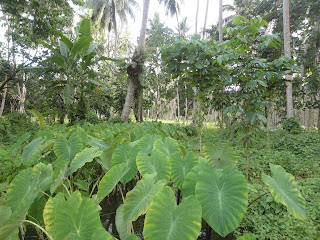Traditional Irrigation Farming and Tree Planting in old Coconut Planation, South Santo.
By: Ioan VijiNakarai
Wednesday, March 26, 2014
In 2009 the Vanuatu Government received funding through South Pacific Commission at the Land Resource Division for a Regional Program on Sustainable Land Management (SLM). Thanks to the Venusvela Government for providing funding for the regional SLM project. The focal point for the project is the Department of Lands and the Department of forests was fortunate to be part of the project in its field activity implementation.
One of sites was at Tangoa Island mainland, South of Santo. The site was selected because the status of SLM is poor. The site consists of old coconut trees with yield lower, pasture poorly managed, vegetation health indicated soil nutrient deficiency and soil is prone erosion during heavy rains.
The design in this SLM site of old cocoanut plantation included mixed planting of trees for timber and indigenous fruit orchard, Sandalwood and traditional irrigation for food crops. The total area was two hectares (2ha). The farmer Mr. Livo Ropo is a member of family who inherits traditional skills and knowledge of traditional irrigation water taro farming.
Main reasons for this design were to address; good practice of SLM, food security, reforestation, utilization of water resource, reduce soil erosion and creating a habitat for biodiversity.
In 2009 the two hectares area was fenced and the farmer grew trees included; Sandalwood, Natapoa, Mahogany, Citrus, Guava, Namambe, Naus. And the farmer diverted water to the old coconut plantation and grew water taro in the traditional irrigation.
In 2010 to 2013 the water flows through the dry ground and taros grow with much vigor and healthy. There was also evidence of colonization of fresh water prawns and other fresh water fish. The trees are growing healthy and there is visitation of birds to the site and natural regeneration of other indigenous plant species into the two hectare area.
Sufficient food crop for farmer and family.
Mr. Livo Ropo standing with his trees and taro in the farm of two hectares.
Today the farmer is able to supply food sources for this family and earn a small income from surplus of his food crops. And at an old age the farmer still find energy every day enjoying his daily chores of maintenance of garden and continue planting trees in the same area of two hectares.
The advantage of this farming design ranges and to list a few; no new forest is to be cleared for gardening for food, the river supplies abundant nutrient to the taro water, there is source of healthy food - carbohydrate, greens and protein available, colonization of flora and fauna in the area, farmer no longer depend on a colonial crop such as coconut and this tasks are much less laborious.
It was not an easy choice to take because the farmer who once had a nuclear family now has grown to an extended family with a bigger number of persons also depending on the same piece of land. For the farmer the coconut is not enough to supply let alone supply of food. With coconut or copra the farmer sells the copra, gets the money and has to pay for imported food such as rice, sugar, salt and other necessities in life.
The farmer now has no regret to the decision made as he was able to grow water taro on the same piece of and feed his extended family and has time to do other things. When the farmer needs cash he can harvest his water taro and sell in the local market and there appears to be a higher demand for water taro for food and other ceremonial purposes he supplies.
With better design or model of agro-forestry system with the traditional irrigation farming system the farmers will be able to get short and long term benefit and a maximized.



Comments
Post a Comment